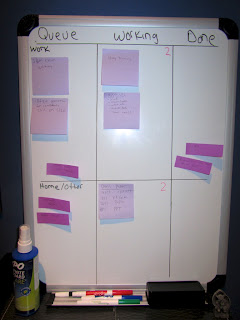I recently had a couple articles (here & here) published in Projects at Work based on some discussions I had at the Project Flow 2011 conference. I'll admit going into this conference I wasn't an expert on Critical Chain. In one of my articles, I compared Critical Chain to Agile and came to the conclusion that Critical Chain is not a form of Agile. However, that doesn't mean they can't co-exist.
For those unfamiliar with it, Critical Chain is the project management approach based on Theory of Constraints (TOC), all based on books by the late Eliyahu M. Goldratt. Goldratt's books are interesting because they are written as novels, not text books.
The PMI Agile Community of Practice had a tweetchat last week on scaling agility with Mike Cottmeyer. One of Mike's comments was about Theory of Constraint. Mike tweeted that at the lowest level in an agile organization are small projects using Scrum. At the higher level, TOC or Kanban can come into play as the work should take on more of a flow. Mike recommended reducing the dependencies between projects and reducing bottlenecks (full Tweetchat text can be found here for PMI Agile CoP members).
So what does this mean to you? One lesson to take from all of this is that we need to constantly keep our skills up to date. Earning your CSM is good, but not enough. You need to pick up on other techniques as well, so find a conference, pick up a book or two, or get involved with the PMI Agile Community of Practice. This way you can scale up your personal skills in agile.




